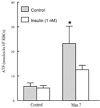Insulin inhibits human erythrocyte cAMP accumulation and ATP release: role of phosphodiesterase 3 and phosphoinositide 3-kinase
- PMID: 20404042
- PMCID: PMC2892266
- DOI: 10.1258/ebm.2009.009206
Insulin inhibits human erythrocyte cAMP accumulation and ATP release: role of phosphodiesterase 3 and phosphoinositide 3-kinase
Abstract
In non-erythroid cells, insulin stimulates a signal transduction pathway that results in the activation of phosphoinositide 3-kinase (PI3K) and subsequent phosphorylation of phosphodiesterase 3 (PDE3). Erythrocytes possess insulin receptors, PI3K and PDE3B. These cells release adenosine triphosphate (ATP) when exposed to reduced O(2) tension via a signaling pathway that requires activation of the G protein, Gi, as well as increases in cAMP. Although insulin inhibits ATP release from human erythrocytes in response to Gi activation by mastoparan 7 (Mas 7), no effect on cAMP was described. Here, we investigated the hypothesis that insulin activates PDE3 in human erythrocytes via a PI3K-mediated mechanism resulting in cAMP hydrolysis and inhibition of ATP release. Incubation of human erythrocytes with Mas 7 resulted in a 62 +/- 7% increase in cAMP (n = 9, P < 0.05) and a 306 +/- 69% increase in ATP release (n = 9, P < 0.05), both of which were attenuated by pre-treatment with insulin. Selective inhibitors of PDE3 (cilostazol) or PI3K (LY294002) rescued these effects of insulin. These results support the hypothesis that insulin activates PDE3 in erythrocytes via a PI3K-dependent mechanism. Once activated, PDE3 limits Mas 7-induced increases in intracellular cAMP. This effect of insulin leads, ultimately, to decreased ATP release in response to Mas 7. Activation of Gi is required for reduced O(2) tension-induced ATP release from erythrocytes and this ATP release has been shown to participate in the matching of O(2) supply with demand in skeletal muscle. Thus, pathological increases in circulating insulin could, via activation of PDE3 in erythrocytes, inhibit ATP release from these cells, depriving the peripheral circulation of one mechanism that could aid in the regulation of the delivery of O(2) to meet tissue metabolic need.
Figures





Similar articles
-
A selective phosphodiesterase 3 inhibitor rescues low PO2-induced ATP release from erythrocytes of humans with type 2 diabetes: implication for vascular control.Am J Physiol Heart Circ Physiol. 2011 Dec;301(6):H2466-72. doi: 10.1152/ajpheart.00729.2011. Epub 2011 Sep 30. Am J Physiol Heart Circ Physiol. 2011. PMID: 21963837 Free PMC article.
-
Phosphodiesterase 3 is present in rabbit and human erythrocytes and its inhibition potentiates iloprost-induced increases in cAMP.Am J Physiol Heart Circ Physiol. 2008 Aug;295(2):H786-93. doi: 10.1152/ajpheart.00349.2008. Epub 2008 Jun 27. Am J Physiol Heart Circ Physiol. 2008. PMID: 18586889 Free PMC article.
-
Reduced expression of G(i) in erythrocytes of humans with type 2 diabetes is associated with impairment of both cAMP generation and ATP release.Diabetes. 2006 Dec;55(12):3588-93. doi: 10.2337/db06-0555. Diabetes. 2006. PMID: 17130508
-
Regulation of cAMP by phosphodiesterases in erythrocytes.Pharmacol Rep. 2010 May-Jun;62(3):475-82. doi: 10.1016/s1734-1140(10)70303-0. Pharmacol Rep. 2010. PMID: 20631411 Free PMC article. Review.
-
Erythrocytes as controllers of perfusion distribution in the microvasculature of skeletal muscle.Acta Physiol (Oxf). 2011 Jul;202(3):285-92. doi: 10.1111/j.1748-1716.2010.02182.x. Epub 2010 Oct 11. Acta Physiol (Oxf). 2011. PMID: 20731624 Free PMC article. Review.
Cited by
-
Lymphatic vascular integrity is disrupted in type 2 diabetes due to impaired nitric oxide signalling.Cardiovasc Res. 2015 Jul 1;107(1):89-97. doi: 10.1093/cvr/cvv117. Epub 2015 Apr 7. Cardiovasc Res. 2015. PMID: 25852084 Free PMC article.
-
A selective phosphodiesterase 3 inhibitor rescues low PO2-induced ATP release from erythrocytes of humans with type 2 diabetes: implication for vascular control.Am J Physiol Heart Circ Physiol. 2011 Dec;301(6):H2466-72. doi: 10.1152/ajpheart.00729.2011. Epub 2011 Sep 30. Am J Physiol Heart Circ Physiol. 2011. PMID: 21963837 Free PMC article.
-
Defects in oxygen supply to skeletal muscle of prediabetic ZDF rats.Am J Physiol Heart Circ Physiol. 2010 Jun;298(6):H1661-70. doi: 10.1152/ajpheart.01239.2009. Epub 2010 Mar 5. Am J Physiol Heart Circ Physiol. 2010. PMID: 20207810 Free PMC article.
-
Vascular disease in pre-diabetes: new insights derived from systems biology.Mo Med. 2010 Jul-Aug;107(4):265-9. Mo Med. 2010. PMID: 20806839 Free PMC article.
-
Reduced deformability contributes to impaired deoxygenation-induced ATP release from red blood cells of older adult humans.J Physiol. 2019 Sep;597(17):4503-4519. doi: 10.1113/JP278338. Epub 2019 Jul 27. J Physiol. 2019. PMID: 31310005 Free PMC article.
References
-
- Tooke JE. Microvascular function in human diabetes. A physiological perspective. Diabetes. 1995;44:721–726. - PubMed
-
- Wiernsperger N. Defects in microvascular haemodynamics during prediabetes: contributor or epiphenomenon? Diabetologia. 2000;43:1439–1448. - PubMed
-
- Shrot P, Sahebzamani FM, Brownlee HJ., Jr Case Study: Screening and Treatment of Pre-Diabetes in Primary Care. Clinical Diabetes. 2004;22:98–100.
-
- Benjamin SM, Valdez R, Geiss LS, Rolka DB, Narayan KM. Estimated number of adults with prediabetes in the US in 2000: opportunities for prevention. Diabetes Care. 2003;26:645–649. - PubMed
Publication types
MeSH terms
Substances
Grants and funding
LinkOut - more resources
Full Text Sources
Medical

